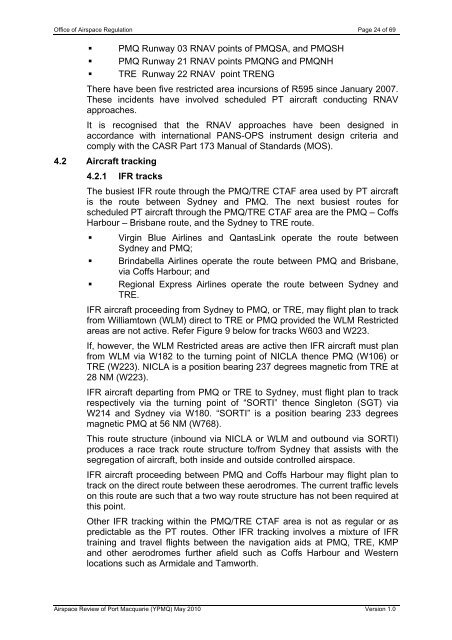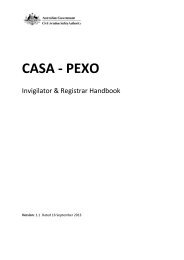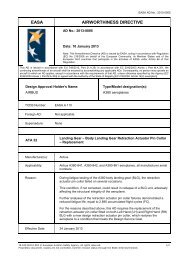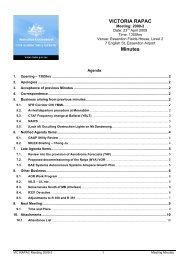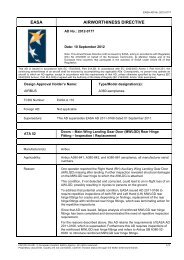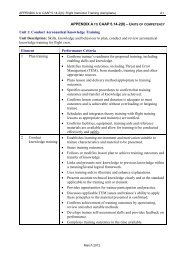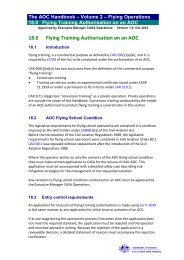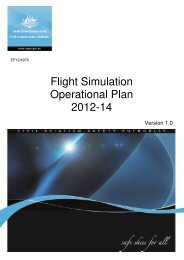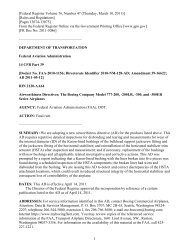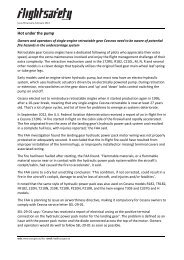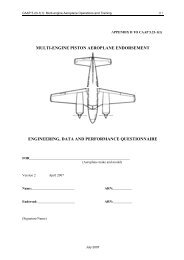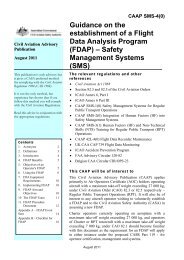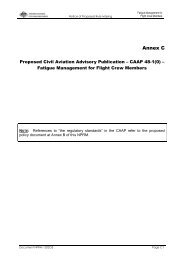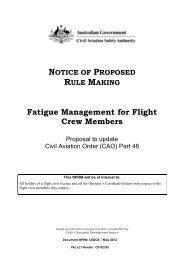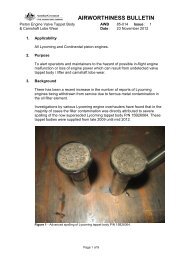Aeronautical Study of Port Macquarie - Civil Aviation Safety Authority
Aeronautical Study of Port Macquarie - Civil Aviation Safety Authority
Aeronautical Study of Port Macquarie - Civil Aviation Safety Authority
You also want an ePaper? Increase the reach of your titles
YUMPU automatically turns print PDFs into web optimized ePapers that Google loves.
Office <strong>of</strong> Airspace Regulation Page 24 <strong>of</strong> 69<br />
�<br />
�<br />
�<br />
�<br />
�<br />
�<br />
PMQ Runway 03 RNAV points <strong>of</strong> PMQSA, and PMQSH<br />
PMQ Runway 21 RNAV points PMQNG and PMQNH<br />
TRE Runway 22 RNAV point TRENG<br />
There have been five restricted area incursions <strong>of</strong> R595 since January 2007.<br />
These incidents have involved scheduled PT aircraft conducting RNAV<br />
approaches.<br />
It is recognised that the RNAV approaches have been designed in<br />
accordance with international PANS-OPS instrument design criteria and<br />
comply with the CASR Part 173 Manual <strong>of</strong> Standards (MOS).<br />
4.2 Aircraft tracking<br />
4.2.1 IFR tracks<br />
The busiest IFR route through the PMQ/TRE CTAF area used by PT aircraft<br />
is the route between Sydney and PMQ. The next busiest routes for<br />
scheduled PT aircraft through the PMQ/TRE CTAF area are the PMQ – C<strong>of</strong>fs<br />
Harbour – Brisbane route, and the Sydney to TRE route.<br />
Virgin Blue Airlines and QantasLink operate the route between<br />
Sydney and PMQ;<br />
Brindabella Airlines operate the route between PMQ and Brisbane,<br />
via C<strong>of</strong>fs Harbour; and<br />
Regional Express Airlines operate the route between Sydney and<br />
TRE.<br />
IFR aircraft proceeding from Sydney to PMQ, or TRE, may flight plan to track<br />
from Williamtown (WLM) direct to TRE or PMQ provided the WLM Restricted<br />
areas are not active. Refer Figure 9 below for tracks W603 and W223.<br />
If, however, the WLM Restricted areas are active then IFR aircraft must plan<br />
from WLM via W182 to the turning point <strong>of</strong> NICLA thence PMQ (W106) or<br />
TRE (W223). NICLA is a position bearing 237 degrees magnetic from TRE at<br />
28 NM (W223).<br />
IFR aircraft departing from PMQ or TRE to Sydney, must flight plan to track<br />
respectively via the turning point <strong>of</strong> “SORTI” thence Singleton (SGT) via<br />
W214 and Sydney via W180. “SORTI” is a position bearing 233 degrees<br />
magnetic PMQ at 56 NM (W768).<br />
This route structure (inbound via NICLA or WLM and outbound via SORTI)<br />
produces a race track route structure to/from Sydney that assists with the<br />
segregation <strong>of</strong> aircraft, both inside and outside controlled airspace.<br />
IFR aircraft proceeding between PMQ and C<strong>of</strong>fs Harbour may flight plan to<br />
track on the direct route between these aerodromes. The current traffic levels<br />
on this route are such that a two way route structure has not been required at<br />
this point.<br />
Other IFR tracking within the PMQ/TRE CTAF area is not as regular or as<br />
predictable as the PT routes. Other IFR tracking involves a mixture <strong>of</strong> IFR<br />
training and travel flights between the navigation aids at PMQ, TRE, KMP<br />
and other aerodromes further afield such as C<strong>of</strong>fs Harbour and Western<br />
locations such as Armidale and Tamworth.<br />
Airspace Review <strong>of</strong> <strong>Port</strong> <strong>Macquarie</strong> (YPMQ) May 2010 Version 1.0


